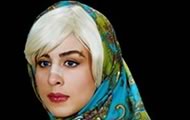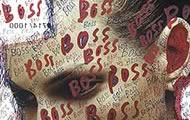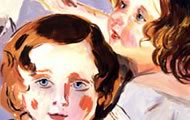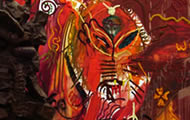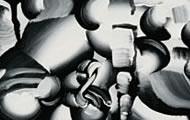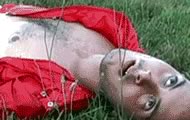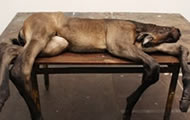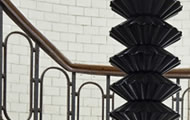A way with words
Modernedition spoke to Alexandra Grant about her career and influences - and were suitably impressed by what she had to say
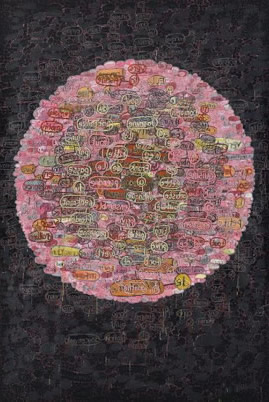
We'd like to start with the most obvious question - why the use of text in your work?
Why text? My first impulses to make art came from a need to create both a native language and place for myself. I grew up moving from Mexico to France to Spain to the US - the daughter of an American diplomat and a Scottish geologist. I became a keen observer of what is gained and lost in translation as people, books, and ideas move from culture to culture, context to context.
As an art student I became interested in exploring the liminal moment when a word becomes an image of a word. That was an opening for me to explore, through drawing and painting, the visual qualities of literary language.
The texts I work with function as 'hypertexts', a term coined by Ted Nelson to mean "a body of written or pictorial material interconnected in such a complex way that it could not conveniently be presented or represented on paper."
The thought that representing language and complex systems might be impossible in 2D is very much the kind of challenge I enjoy.
Do you choose any particular sources for your texts?
I've worked consistently with poetic texts, found or borrowed. Poetry, more than prose, employs form and rhythm; repetition, alliteration and rhyming easily translate to a visual mapping (at least in my imagination).
After years of searching for a living writer with whom to work, I stumbled upon one of Michael Joyce's hypertext fictions online, not knowing who the writer was. Michael and I have now worked together consistently for over four years.
I use his texts as a starting place and respond to them, reject them, embellish them with lyrics from the radio, my own thoughts. In many ways the finished pieces become idealized conversations.
Would you regard your work as in any way characteristic of the Los Angeles / West Coast scene? And what prompted you to settle in LA?
I had a studio visit from someone who had just visited Mark Bradford's studio and said that Mark and I both used the word "constellations" to describe our work.
Ad featureflights fares plane deals cheap air travel
Los Angeles is a constellation, with points being home and work, the places one visits and eats and shops, one's friends and colleagues, secrets and shames. So perhaps there is some formal response by artists to this city of personal constellations - making or failing to make connections across a constantly shifting and isolating environment.
More practically, I was attracted to the city because it is amenable: rent is cheap and the weather extreme only in the summer. There is a strong history of conceptual and language-based art practice, the city is bilingual, and there are so many pioneering knowledge-based institutions present, from CalTech to the Museum of Jurassic Technology and MOCA to Hollywood.
I didn't go to art school in Los Angeles; which had some effect on my understanding of the city; I didn't have a system to plug into and could explore the city and my interests without any pressure.
There are so many artists who have experimented wildly here - Baldessari, Irwin, McCarthy, etc. Pushing boundaries and making connections seem to be two very loose Los Angeles tendencies.
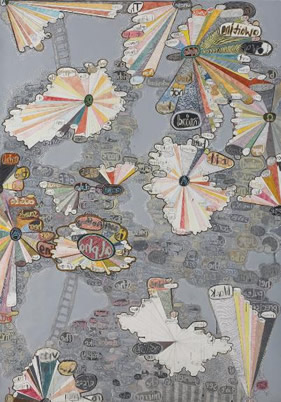
Which artists would you cite as a personal influence?
Part of my childhood was spent in Mexico City, and I had strong relationships
to Mexican art, both traditional folk art and Modernist practices in art
and architecture.
I have been affected by artists as diverse as R.B. Kitaj (who in my teenage mind cleared the way for the artist as engager with literature) and the Venezuelan Gego (Gertrud Goldschmidt).
But there are so many influences: Cézanne, Morandi, Bryce Marden, Peter Doig in painting... among others. Surrealists and later-surrealists, of course: Picabia and Broodthaers to name two. Absent are many contemporaries and everyone else I will think of once I finish the interview.
Language, particularly literary language, is inherently rhythmic. Is music also an influence in your work?
Yes, in many ways. First, the way in which painting and making music are often evoked in terms of the other - I often describe my collaboration with Michael as working with a score or script that I then interpret as a jazz musician would, riffing off the page.
Second, I admire the structure of music itself, the obsession involved in 'writing' music and interpreting it, the mathematics of composition, the notion of 'symphonic' thinking. Third, I'm influenced by what I listen to in the studio.
Are there any other specific referents or influences you'd like to mention?
I have been influenced by my mother's internationalism and belief in Liberal Arts education, by my father's following of Anthroposophy and Rudolph Steiner.
Years ago I read Three Steps on the Ladder of Writing by Hélène Cixous. Her voice - that of a German-Jewish North African woman making room within French philosophic discourse - inspired me to dream about creating my own 'mother tongue' with which to make sense of my many interests.
Cixous also wrote about being a writer with a paintbrush heavy with words - "How does one write a painting?" she asked. I don't think she expected me to answer, but her question touches on the more abstract side of my practice: looking at language visually (rather than just reading it).
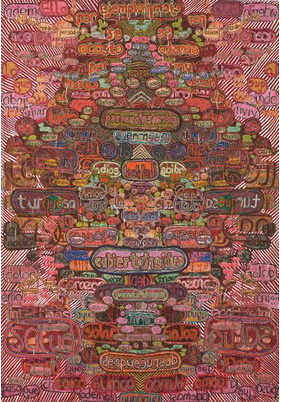
Is it true that you devise your own systems in order to map out works?
Yes. I don't sketch out my work. I set up a system that includes 1) a seed text; 2) a series of rules about color, composition, scale (in a drawing, for example: repeat text 10 times in pencil then switch to color; 3) an architectonic or symbolic motif (I've used ladders, capital letters, the cube form); and lastly, 4), materials.
The process of enacting these systems creates the work. I have a very general idea of what it will look like when I begin.
The text in your work is often written backwards or made somehow difficult to decipher. Is this to focus the viewer's concentration; perhaps make words seem less 'wordy', more abstract?
Yes, all those things. When the words are the right way round the viewer spends all his or her time 'reading' the words, making sense of them. When words are backwards the mind stops trying to read them and instead makes sense of them as an image.
Words then become images of 'language' and take on other, emotional qualities present in paintings and sculpture. What I mean by that is that the mind starts 'reading' color and composition, the weight of line, the intensity of gesture.
I once overheard a class discussing my work. The teacher asked about the backwards text. A student responded, "I think the artist is trying to teach us the difference between seeing and perceiving."
Do you see yourself moving in direct directions in terms of medium, formats, even themes?
In my recent show at Honor Fraser gallery, I worked in large-scale sculpture (a mobile) and in video, which included language as sound. There's certainly more to explore there.
Right now, I'm deep in a Research and Development phase - working in gold-smithing, baking, etching, glass, clay, sewing. I constantly evolve and explore ideas; taking an idea from one medium to another can open up new ways of thinking (and frankly, of failing).
At the same time I'm in the studio involved in the process of creating a new series of drawings and paintings.
Any projects that you're particularly excited about?
Yes; my new series of drawings of circular forms called 'nimbos' - Spanish for 'nimbus' - clouds of text. These are in the studio.
Outside the studio I'm developing a large-scale intervention for the Watts House Project, an arts-driven redevelopment project across the street from Watts Towers.
As an artist closely involved with text - could you tell us what you're reading at the moment?
Today? The New York Review, Celine's 'Journey to the End of the Night', Bolano's 'Savage Detectives', and any glossy magazines that arrived in the mail (art, fashion and mail order catalogs - anything that stimulates new ideas).
top picks...
modernedition: limited editions

wade guyton - more
fred tomaselliolafur eliasson
pierre huyghe
jonathan monk
thomas scheibitz
